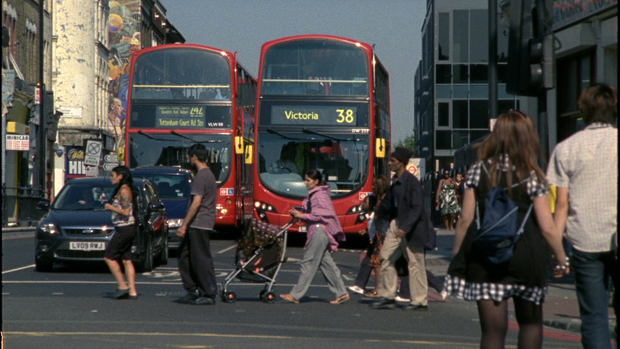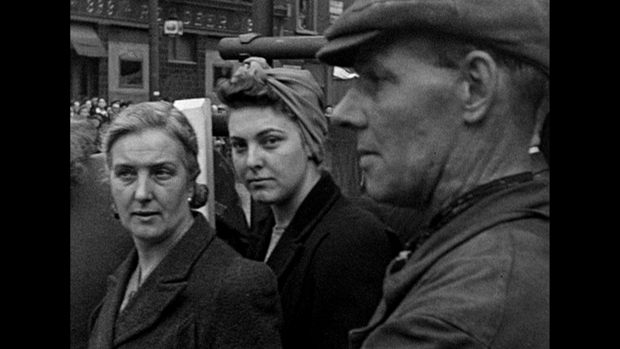You have no items in your cart. Want to get some nice things?
Go shopping
Cities are challenging, both to live in and to define. They are each a unique life form constructed from many smaller ones. For some they are amazing, baffling or frustrating, particularly for the planners and architects responsible for so much of the life that goes on within them. For others, they are a place for living. You may feel alone in the city but you are actually always among others.
Art provides us with various creative methods for engaging with the complexity of urban environments. “We need art,” writes Jane Jacobs in her book The Death and the Life of Great American Cities, “to show us meanings, to illuminate the relationship between the life that each of us embodies and the life outside us.” Owing to the intimate relationship it maintains with its subject matter, Under The Cranes, from the first-time filmmaker Emma-Louise Williams, is a lively and complex portrait of Hackney that does not conform to conventional genres, nor does it attempt to explain or document Hackney in any straightforward manner. Instead it is both an artistic response to the area in film and sound, and an adaptation of a “play for voices” about the East London borough, written by the children’s writer and broadcaster Michael Rosen. The film is also a gentle provocation, challenging the rhetoric of council-led regeneration and development initiatives by choosing to focus on the people and the buildings that are affected by various top-down decision-making processes. This focus resists the possibility of the film becoming perhaps too inward-looking, and allows Hackney’s current situation to be considered alongside those of other places around the UK affected by regeneration projects.
The film is incredibly well researched, disclosing various little-known facts about the past and present of Hackney, including its diverse communities and its history of highly skilled manual labour. The adapted script from Hackney Voices is accompanied by original footage of present-day Hackney and rarely seen archive footage depicting social life and events in the borough. It is also interspersed with poignant musical intervals and shots of paintings made of the area that reflect the artistic nature of Williams’ own response in the film.
In its meticulous research, subject matter, and imaginative, trans-temporal narrative, Under the Cranes recalls the writing of Iain Sinclair, or the films of Patrick Keiller, particularly with the long shots and the static camera. However whereas Sinclair and Keiller both maintain a singular, overarching and authoritative narrator throughout their work, this film maintains the kaleidoscope of Hackney Voices from Rosen’s play. It even brings in more new voices (the old woman who explains, “I used to run the buses during the war… not a lot of people know that” was an addition suggested by Williams).
It was Jane Jacobs who wrote, “Intricate minglings of different uses in cities are not a form of chaos. On the contrary, they represent a complex and highly developed form of order.” Not only is there no master narrator that leads a viewer through this film, Under the Cranes, like the urban environment it seeks to portray, is a delicate “mingling” of diverse components that come together in a similarly complex form of order. The words of Jacobs, “Lively, diverse, intense cities contain the seeds of their own regeneration,” are a fitting epigraph to this film, where spoken words and pictures jostle and interweave in friendly and lively difference.
The editing of sound and images is carefully done and a sophisticated achievement. For example, in one moment from the film, we see archive footage of slum housing from the early 20th Century. At the same time a male narrator recalls the sight of decrepit and falling-down housing, which corresponds with this footage, but suddenly the camera cuts to a present-day shot of the interior of Sutton House and the narrator talks about a man named Burbage building a theatre. At this moment we realise that the voice actually belongs to William Shakespeare, and that we have seamlessly traveled backwards and forwards through time over hundreds of years, simultaneously, in a matter of minutes. The ability to achieve such instantaneous and simultaneous time-space travel is unique to film and brilliantly executed here. It is as the British film artist Tacita Dean explained, “Art on film makes us conscious of the time and space we occupy, and gives us an insight into the nature of time itself.” Chronological time is here revealed to be in fact merely an idea among many others. It is the people in this film, with all their idiosyncratic stories, that are seen to endure.
The film has been accused of being nostalgic, presumably suggesting that the film is in some way delusional (nostalgia in Western cultures was first diagnosed as a psychological illness that inflicted soldiers at war), or that it in some way romanticises Hackney. Beyond the fact that there is nothing romantic about the decrepit buildings, squalid living conditions or fascist, anti-Semitic rallies that feature in the archive footage (as Williams has been keen to emphasise in post-film Q&A sessions), I find such observations about the film to be misjudged. A lot of the archive footage in the film features the lives of working people and their families. When cameras were still a novelty in the everyday lives of ordinary people, they tended to be reserved for celebrations or happy occasions (in fact, they often still are if the pictures on most people’s Facebook profiles account for anything). The early, domestic still-image cameras didn’t work properly unless it was a sunny day, hence giving the misguided perception that it was always sunny, back in those days. It seems unfortunate that the film’s focus on everyday people through its use of the archive might be mistaken for being merely a nostalgic tendency, when it seems more appropriately an attempt to bring working-class people back into the history of what is a working-class area, through a considered use of images.

Nostalgia, as Milan Kundera explained in his novel Ignorance, is precisely the feeling of an unappeased longing to return somewhere. The Welsh, as it happens, have their own word for nostalgia: hiraeth, which has no direct English translation but means, approximately, the longing for a home that no longer exists, or perhaps never did. While Under the Cranes makes emotional and bittersweet references to the past lives of Hackney, it never appears to express longing for a lost past. On the contrary, the film demonstrates how much the past and present are intimately connected. It is critical of the loss of London’s progressive post-war social housing initiatives, and their replacement with profit-driven regeneration projects. But when considered alongside other recent works that document and lament these various and seemingly irreconcilable changes—such as Ian Sinclair’s book Hackney, That Rose Red Empire, and the more recent London Preambulator and The Four Aces—Under the Cranes stands out for its unique form of optimism. Far from nostalgic delusion and longing, there is instead a sense that overcoming struggle is historically part of the fabric of this area. And history is a bit like a London bus: it goes round and round and, as Rosen’s poem reassures us, “It’ll get there today. And it’ll get there tomorrow.”
The next screening of Under the Cranes will be at the Bishopsgate Institute on Wednesday, 13 February 2013 at 7pm. For more information and to arrange a screening of the film, visit underthecranes.blogspot.com, and follow @underthecranes on Twitter.

About Becky Ayre
Becky is a writer, editor and researcher of visual arts and the environment. She lives in Oxford. She works collaboratively with Inheritance Projects—a small group of independent curators and researchers that organise exhibitions, events, new commissions, publications and research projects. She blogs at Atmospheres of Uncertainty.




